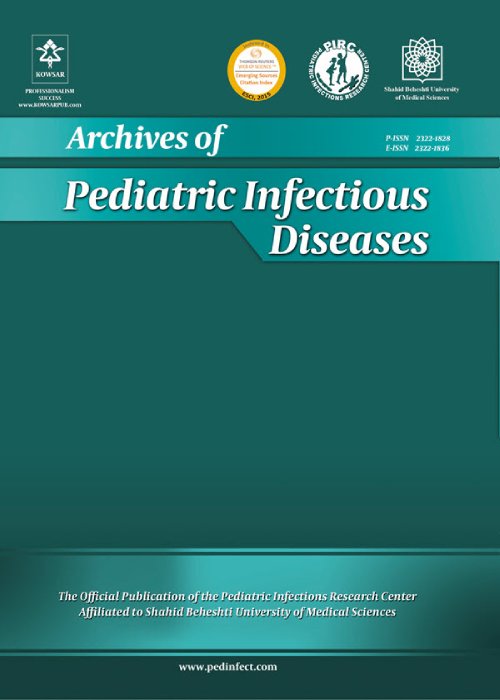Distribution of Aminoglycoside Resistance Genes in Coagulase-Negative Staphylococci Isolated From Hospitalized Patients
Author(s):
Abstract:
Background
The incidence of coagulase-negative staphylococci (CNS) isolates, as causes of hospital-acquired infections, is increasing annually and it is a truly global challenge.Objectives
The current study aimed at assessing aminoglycoside resistance genes among CNS isolated from hospitalized patients and investigating the prevalence of methicillin and aminoglycoside resistance genes using molecular methods.Methods
A total of 103 species of coagulase negative staphylococci were isolated from clinical specimens from August 2013 to November 2014. All the specimens were identified using conventional microbiological methods including colony morphology, Gram staining, catalase, and slide and tube coagulase. The isolates were subjected to the API-20 Staph identification kit. Antibiotic susceptibility tests were performed using Kirby-Bauer disc diffusion method. The methicillin and aminoglycoside resistant genes among coagulase negative staphylococci were detected by polymerase chain reaction (PCR) and sequencing methods.Results
The most frequent clinically isolated coagulase negative staphylococci species were Staphylococcus hominis and S. haemolyticus (51. 9%), S. epidermidis (21. 7%), S. lugdunensis (9. 8%), S. intermedius (4. 9%), S. saprophyticus and S. simulans (3. 9%), S. warneri (2. 9%), as well as S. chromogenes, S. sciuri, S. caprae, S. schleiferi, and S. xylosus (0. 98%). The overall rate of methicillin resistance among CNS species in the present study was 89 (86. 4%). The resistance of CNS isolates against tested antibiotics was as follows: 74 (71. 8%) to cefoxitin, 54 (52. 4%) to kanamycin, 51 (49. 5%) to gentamicin, 45 (43. 7%) to tobramycin, and 30 (29. 1%) to amikacin. The prevalence of aminoglycoside resistance genes such as ant (4'') -Ia, aac (6'') /aph (2«) and aph (3'') -IIIa were 89 (86. 4%), 87 (84. 5%), and 68 (66%), respectively.Conclusions
The presence of antibiotic resistance among coagulase negative Staphylococcus species, which cause nosocomial infections, has increased. Therefore, identification of coagulase negative staphylococci within 24 hours after development of enzymatic tests would be very useful in any clinical microbiology laboratory for effective treatment. Resistance to antibiotics, including aminoglycosides, develops quickly in CNS species where these antimicrobial agents are widely used. Thus, a better understanding of antibiotic resistance of CNS species is essential to eliminate antibiotic resistance in hospitals and society. Language:
English
Published:
Archives of Pediatric Infectious Diseases, Volume:5 Issue: 3, Jul 2017
Page:
9
magiran.com/p1719446
دانلود و مطالعه متن این مقاله با یکی از روشهای زیر امکان پذیر است:
اشتراک شخصی
با عضویت و پرداخت آنلاین حق اشتراک یکساله به مبلغ 1,390,000ريال میتوانید 70 عنوان مطلب دانلود کنید!
اشتراک سازمانی
به کتابخانه دانشگاه یا محل کار خود پیشنهاد کنید تا اشتراک سازمانی این پایگاه را برای دسترسی نامحدود همه کاربران به متن مطالب تهیه نمایند!
توجه!
- حق عضویت دریافتی صرف حمایت از نشریات عضو و نگهداری، تکمیل و توسعه مگیران میشود.
- پرداخت حق اشتراک و دانلود مقالات اجازه بازنشر آن در سایر رسانههای چاپی و دیجیتال را به کاربر نمیدهد.
دسترسی سراسری کاربران دانشگاه پیام نور!
اعضای هیئت علمی و دانشجویان دانشگاه پیام نور در سراسر کشور، در صورت ثبت نام با ایمیل دانشگاهی، تا پایان فروردین ماه 1403 به مقالات سایت دسترسی خواهند داشت!
In order to view content subscription is required
Personal subscription
Subscribe magiran.com for 70 € euros via PayPal and download 70 articles during a year.
Organization subscription
Please contact us to subscribe your university or library for unlimited access!


